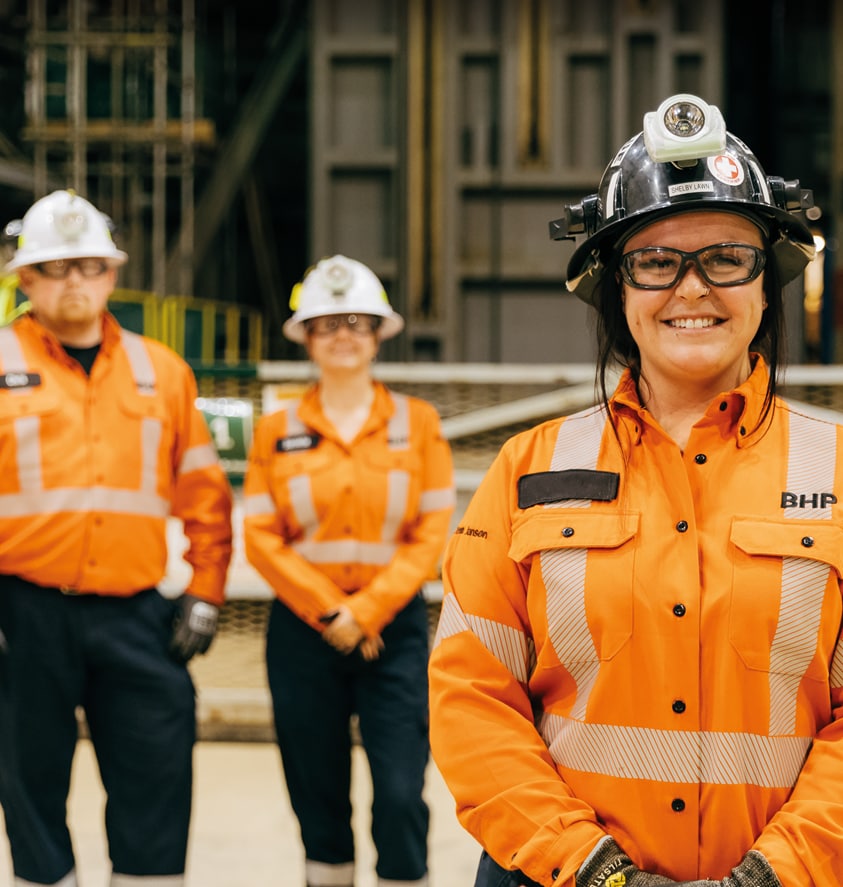Our approach to transparency and tax
BHP has a strong commitment to the highest standards of corporate governance and transparency. Being open about taxes and royalties we pay to governments helps build trust with our shareholders, employees, customers, the communities where we operate and other stakeholders. Transparency allows an informed debate on the integrity of tax regimes and the contribution we do and should make in the countries where we operate.
We began our journey of voluntarily disclosing our payments of taxes and royalties in 2000 when we first disclosed these payments in our Environment and Community Report. Since then, we have progressively increased the detail of these annual disclosures meeting global and local tax transparency requirements but also voluntarily disclosing additional information above these requirements.
Chief Financial Officer’s review
BHP’s total direct economic contribution for FY2025 was US$46.8 billion. This includes payments to suppliers, wages and benefits for over 90,000 employees and contractors, dividends, taxes, royalties and voluntary investment in social projects across the communities where we operate.
In FY2025, our tax, royalty and other payments to governments totalled US$10.4 billion. Of this, 65 per cent or US$6.8 billion (approximately A$10.5 billion) was paid in Australia. BHP was one of the largest corporate taxpayers in Australia in FY2025. During the last decade, we paid US$98.1 billion globally in taxes, royalties and other payments to governments, including US$78.1 billion (approximately A$103.1 billion) in Australia. Our global adjusted effective tax rate in FY2025 was 37.2 per cent. Once royalties are included, our FY2025 rate increases to 44.6 per cent.
This significant contribution of tax and royalty revenue to the countries where we operate is important. It gives governments the opportunity to provide essential services to their citizens and invest in their communities for the future. We also create value for our shareholders and investors through the returns we provide. In FY2025, we paid US$6.3 billion in cash dividends to shareholders (FY2024 final dividend and FY2025 interim dividend), including many millions of Australians who hold BHP shares directly or via their superannuation.
In FY2025, we contributed US$24.8 billion to our suppliers globally. BHP-operated projects spent over US$3.2 billion with more than 2,500 small, local and Indigenous businesses in the communities where we operate. This contribution typically has a multiplier effect by creating new jobs within our operations and within the suppliers they rely on.

FY2025 total economic contribution
-
Our tax principles
-
How we create and deliver value
-
Downloads
Our Charter and Our Code of Conduct (Our Code) define how we work at BHP. Our Charter describes our purpose, our strategy and Our Values. It is the single most important means by which we communicate who we are, what we do and what we stand for, and is the basis for our decision-making. Supporting Our Charter is Our Code, which brings Our Values to life so we can make the right choices every day.
Our approach to tax is underpinned by Our Charter and Our Code, and is embodied in our Tax Principles. The Risk and Audit Committee of the BHP Board endorsed these principles and in FY2025, we conducted annual assurance that we have adhered to our Tax Principles.
Our Tax Principles
1. Transparency
We are transparent about the taxes and royalties we pay to governments because we believe openness allows our shareholders, employees, contractors, partners, customers and communities to understand the contribution we make and have a greater ability to assess the integrity of the tax systems in the countries where we operate.
2. Corporate citizenship
We act with integrity when engaging with revenue authorities to support positive and constructive relationships. Where possible, for the purposes of obtaining certainty of our tax positions, we engage with revenue authorities on a real-time basis regarding the application of the tax law and to identify and resolve any disagreements on a timely basis.
3. Risk management and governance
We are committed to strong governance. We identify, assess and manage tax risks in accordance with our global Risk Framework. Material risks are reported to the Risk and Audit Committee. For more information refer to page 17 of the BHP Economic Contribution Report 2025.
4. Business rationale
Our transactions have proper commercial purposes and economic rationale. We locate business activities where value is optimally created. We seek to have a tax charge that contributes to superior business performance and delivers long-term shareholder value. Accordingly, we do not engage in aggressive tax planning.
5. Compliance
We respect and comply with the laws of the countries where we operate. We meet all of our tax compliance obligations on time. Our tax obligations include pricing transactions in our global value chain according to where value is created and economic activity occurs, in compliance with the OECD guidelines, and based on the arm’s length principle.
6. Advocating reform
We support simple, stable and competitive tax rules and the principle that the taxing rights of countries should be commensurate with where the economic activity occurs. We engage in the reform process of international tax rules (including transfer pricing) and local tax rules in countries where we operate. We do this because we believe tax systems should be effective, efficient and competitive, in order to support economic growth, job creation and viable long-term tax contributions.
We aim to grow value for our shareholders, partners and stakeholders through our portfolio of large, long-life, low-cost assets in attractive commodities, and through our focus on social value. BHP is positioned to benefit from the economic and social megatrends that will drive demand for our commodities in the coming decades.
We work in partnership with communities. We provide employment, purchase goods and services, pay taxes, royalties and other payments to governments and make contributions (such as donations) to the communities where we operate.
The way we work provides a competitive advantage for BHP and is vital to delivering long-term enduring value. Value is created for our shareholders and investors, including pension and superannuation funds, through paying dividends and making other financial returns. We contribute to society more generally as we provide the building blocks essential to modern life for millions of people around the world. In this way, we strive to align with the interests of the communities where we operate and to society more broadly.
How we contribute
Exploration and acquisition
We seek to add high-quality interests through exploration and early-stage entry and the acquisition of new resources.
How we contribute:
- Payments to suppliers and contractors
- Wages paid to employees
- Permits, licence fees and employment taxes
Development and mining
We strive to achieve the industry’s best performance in safety, operational excellence, project management and allocation of capital.
How we contribute:
- Capital expenditure
- Payments to suppliers and contractors
- Wages paid to employees
- Permits and licence fees
- Employment and sales taxes, import duties, property and land taxes
- Contributions to communities where we operate
Process and logistics
We process and refine ore and seek to safely manage waste. Our objective is to efficiently and sustainably transport our products to customers.
How we contribute:
- Net profits – corporate taxes paid
- Royalties paid from extraction
- Payments to suppliers and contractors
- Wages paid to employees
- Employment and sales taxes, import duties
- Contributions to communities where we operate
- Payments to shareholders and investors
Sales, marketing and procurement
We maximise value through our centralised marketing and procurement organisations, commercial expertise, understanding of markets and customer and supplier relationships.
How we contribute:
- Payments to suppliers and contractors
- Wages paid to employees
- Corporate, employment and sales taxes, import duties
Closure and rehabilitation
We consider closure and rehabilitation throughout the asset lifecycle to help minimise our impact and optimise post-closure value for all stakeholders and partners.
How we contribute:
- Payments to suppliers and contractors
- Corporate taxes paid if alternative revenue streams from post-mining land use are found
- Lower employment and sales taxes
2025 reports
-
BHP Annual Report 2025
pdf
17068205

-
BHP Economic Contribution Report 2025
pdf
6115461

-
BHP Annual Report 2025 (ESEF/iXBRL)
zip
17830615

-
BHP Annual Report 2025 (ESEF/iXBRL with built-in iXBRL viewer)
xhtml
34401561

-
BHP Form 20-F 2025
pdf
20231772

-
BHP Economic Contribution Report 2025 XML
xml
47737

-
BHP Economic Contribution Report Extract 2025
pdf
296998

-
BHP Group Modern Slavery Statement 2025
pdf
7308735

-
BHP GHG Emissions Calculation Methodology 2025
pdf
1124687

-
BHP ESG Standards and Databook 2025
xlsx
2541694

-
Límite organizativo de los informes de sostenibilidad, definiciones y descargos de responsabilidad
pdf
234993

-
Sustainability reporting organisational boundary, definitions and disclaimers
pdf
170075

2025 case studies
-
Accelerating water innovation with the Global Water Challenge

-
Advancing the circular economy in Queensland’s resource sector

-
BHP Mitsubishi Alliance Childcare Project

-
BHPs framework to guide our natural capital accounting approach

-
CEO Water Mandate

-
Growing our recruitment talent pool at Escondida

-
Education for the future is not a future problem

-
Embedding and sustaining sexual harassment elimination in BHPs workplaces

-
Empowering abilities

-
Enhancing safety culture and practices with extended reality technology

-
Identifying safety risks and implementing controls at Spence

-
Improving childcare in the Pilbara

-
Improving coastal resilience for Indigenous peoples in Fiji

-
Investing in young minds in regional and rural schools

-
Mapping of important biodiversity and ecosystems

-
Newman Futures

-
One Health

-
Operational Services Maintenance Redesign team

-
Our Commitment to Culture and Community

-
Pilbara Air Quality Program

-
Pilbara surplus water scheme success

-
Project Rise

-
Protecting Australias unique fauna

-
River health partnerships in Queensland Australia

-
Enhancing species baselines using a novel monitoring technique

-
Virtual Future Fit Academy

2024 reports
-
BHP Annual Report 2024
pdf
16192519

-
BHP Annual Report 2024 (ESEF/iXBRL with built-in iXBRL viewer)
xml
51242

-
BHP Annual Report 2024 (ESEF/iXBRL)
zip
18770595

-
BHP Form 20-F 2024
pdf
11394805

-
BHP Climate Transition Action Plan 2024, subject to updates of certain aspects of our assumptions and plans in the BHP Annual Report 2025, Operating and Financial Review 9.8 – Climate change
pdf
8480121

-
BHP Economic Contribution Report 2024
pdf
4504306

-
BHP Economic Contribution Report 2024 XML
xml
50597

-
BHP Economic Contribution Report Extract 2024
pdf
265081

-
BHP Modern Slavery Statement 2024
pdf
4092160

-
BHP GHG Emissions Calculation Methodology 2024
pdf
1028031

-
BHP ESG Standards and Databook 2024
xlsx
2555913

-
Límite organizativo de los informes de sostenibilidad, definiciones y cláusulas de exención de responsabilidad
pdf
6277

-
Sustainability reporting organisational boundary, definitions and disclaimers
pdf
161998

2024 case studies
-
Bamboo flexible work crew

-
BMA Water Allocation

-
Comunidad Mineras

-
Embedding and sustaining sexual harassment elimination in BHPs workplaces

-
Inclusion and Diversity Leadership Forum

-
Operational Services Maintenance Redesign Team

-
Reducing welding fume exposure at Olympic Dam

-
Western Australia Iron Ore Finish and Fill

-
Women Without Limits in Pampa Norte

-
Building strong partnerships at Jansen

-
Indigenous Partners Relationship Health Results 2024

-
Pilbara Air Quality Program

Economic Contribution Report 2025
Download and read our 2025 Economic Contribution Report





